-

人教版新目标初中英语七年级上册How much are these pants教案
个性练习设计 阅读广告:在日常生活中,人们去买东西之前,一般要阅读广告,从广告中获取该商品的一些有用信息,包括价格、性能等。所以给学生提供有些商品的广告或让学生去商店去阅读一些商品的广告,从中获取商品的价格,即可以锻炼学生的阅读能力,又能提高实践能力。 Self Check 教学内容 Self Check(教材P42) 教学目标 知识与能力 复习词汇pant,sock,T-shirt,sweater,shoes,color,black,white,red,green,blue,big,short,long,数字10--31; 学习词汇Zig Zag,clothes,shop,yellow,ask,which;学会谈论服装的价格、颜色、大小和长短;学会填写价格标签。 过程与方法 运用Summarizing和Classifying的学习策略。在复习教学中,运用听写、绘画、互相询问调查与检测等手段,促使学生不断地使用所学内容,从而提高他们灵活运用知识的能力。 情感态度价值观 该部分学习内容主要是复习谈论服装的价格和颜色以及对服装的喜好,能引起学生的共鸣;通过购物的对话练习教学生学会购物时使用的礼貌用语和如何感谢人。

人教版新目标初中英语七年级上册What time do you go to school教案
知识与能力复习词汇time,morning,breakfast,get up,g0 t0 bed,homework,clock,afternoon,lunch,run,watch TV,evening,dinner,eat,usually,o’clock,thirty,fifteen,take a shower,go t0 school等;引导学生复习、巩固“询问和谈论时间”的目标语言并运用所学知识安排自己的学习和课外活动。过程与方法运用Summarizing,Classifying和Comparing的学习策略。在复习教学中,运用听写、提问、对话演练与调查活动,促使学生不断地使用所学内容,从而提高他们灵活运用知识的能力。情感态度价值观本部分的主要内容是复习“日常作息时间”的询问和表达。通过互相询问或谈论自己或对方的作息时间安排和活动计划,培养学生良好的作息习惯和守时习惯。教学重、难点及教学突破重点复习词汇time,morning,breakfast,get up,g0 to bed,homework,clock,afternoon,lunch,run,watch TV,evening,dinner,eat,usually,o’clock,thirty,fifteen,take a shower,go to school等;引导学生复习、巩固“询问和谈论时间”的目标语言。

人教版新目标初中英语七年级下册I ’d like some noodles教案
教学过程Step 1: warming-up Sing a song---------“food and drink” Step 2: Revision1 Dictation2 Revise: What kind of noodles would you like?I’d like …What size bowl of noodles would you like?I’d like…Step 3: Presentation1 show pictures of food, ask students say the words.2 Students read the newspaper ad in 3a. Fill in blanks with words in the box. Then read the ad together, the teacher explains some difficult language points.3 Check the answers Step 4 PracticeAsk students to finish 3b in the same way according to 3a. Students read the short passage and fill in the blanks .At last, check the answers.Step 5 productionAsk students to write their own ad for dumplings, noodles, drinks, and other foods they know. Then ask students to read their partner’s ad. Then order food and drink from their partner.Step 6 Home workGroup work – make an ad about “food and drink”

人教版新目标初中英语七年级下册Where is your pen pal from教案
2.1Match the country with the language.Step II Reading3a? let the students read the letter fast and answer the questions.? Let the students ask more questions about the letter as possible as the can.Step III Writing3b.Step IV. Pairwork2cStep V Listening2a, 2bStep V. HomeworkExercises book(1) P3Exercises book (2) P3Period FourStep I . Dictate the words and sentences in Unit1.Step II. Self-checkStep III. Check the answers for Exercises book in the unit.Step IV. Home workRevise and preparation for unit 2.教学反思:通过本单元的学习,学生基本可以谈论人们的国籍,居住城市及其所说的语言,通过书信方式去介绍自己并寻找笔友。但在涉及到国外的一些城市时,学生对这方面的知识相对欠缺,能介绍的城市并不多,也反应出学生课前预习不充分,这跟学生学习条件也有关,大多数学生无法通过网络获取所需信息。因此,在以后的教学中要多指导学生通过计算机网络获取信息,拓宽知识面。

人教版新目标初中英语七年级下册What do you think of game shows教案
五、教学Section B-2c1. Pair work: What do you think of the belt/sunglasses/…? What does your father/mother/… think of your scarf/belt…?2. Group work(1). Teacher shows some different kinds of school uniforms (制服)and asks : “ What do you think of your school uniforms? If you have a chance to choose your school uniforms, what kind would you like to choose?”(2). Discuss in groups.(3).Get some Ss to report in class.说明:这一步旨在让学生运用已有的语言知识谈论对事物的看法和意见,并简单阐明理由,培养学生的主动思维能力和运用英语的能力。六、教学拓展调查电视节目的收视率任务:调查你周围的人对现在各种电视节目的反响。活动过程:1.教师布置任务,让学生调查周围的人(包括他的亲戚朋友和邻居)喜欢收看哪方面的电视节目。2.学生进行调查活动,运用本单元所学的句型What do you think of….? (Why?)What's your favorite game shows?What do you think of talk show?I doesn’t mind it.I like it.I love it.I can’t stand it.3.记录下排在前10位的TV Program,填写调查表,比较其收视率。

人教版新目标初中英语七年级下册Where did you go on vacation教案
句型: Where did you go on vacation? I went to summer camp.Did she go to Central Park?Yes,she did.No, she didn’t语法:一般过去时特殊疑问句、一般疑问句及肯、否定回答。课时安排4课时第一课时:Section A:la,1b,lc,2a,2b,2c 第二课时:Section A:3a,3b,4第三课时:Section B:1,2a,2b,2c第四课时:Section B:3a,3b,3c,4 and Self Check第一课时教学目标掌握描写假期生活的形容词。假期里自己所做事情的简单表达。谈论假期做的事情及当时情况。谈论假期时旅游的天气,旅游者以及食物等。教学过程一、导入播放一首英文歌曲:Let’s travel 说明:通过让学生听节奏欢快迪斯尼英语歌曲Let’s travel.引入本节课谈论的话题vacation and travel. 让歌曲使学生的思维活跃,增强课堂气氛,激发学生提高学习英语的兴趣。T:How is the trip ?Ss : It’s pretty good/ happy/exciting /relaxing/busy/dangerous/ fantastic说明:这个问题是为了操练形容词。建议让多个Ss作答。鼓励他们用不同的形容词。上述个别形容词本应在第二课时中出现,但可以在warming-up中第一次非正式出现。这些形容词也可在老师的评价语中适时出现,以加深学生对词汇的印象。

人教版新目标初中英语八年级下册Have you ever been to an amusement park教案
(1)Have you ever been to …? Yes, I have. / Yes, I have ever been to …No, I haven’t. / No, I have never been to …(2)When did you go there? I went there last year. (3)I have never been to a water park. Neither have I. I have ever been to an amusement park. So have I. (4)How long have you been studying English? I’ve been studying English since nine o’clock. I’ve been studying English since I came back home. I’ve been studying English for five hours. (5)What’s that? It’s an amusement park in Japan. I’ve never been to an amusement park like it before. It’s fun to learn another language. Let’s go tonight. Isn’t this great?space museum, amusement park, water park, South America, Peru, Holland, European culture, tour guide, flight attendant, musical instrument, more than, be from, get to, take lessons, neither, discover, graduate, change

人教版新目标初中英语八年级下册Would you mind turning down the music教案
Step 4. Group work (4)1. Ask a pair of students to read the dialogue. Say, This activity provides speaking, listening and writing practice using the target language.2. Ask students to complete the work in groups.3. Check the answers with the whole class. 4. Explain some of the language points. Step 5. Word review (Self check 1)1. Ask students to read the words and the phrases given. 2. Fill in the blanks with proper forms of these words to complete the sentences. 3. Check the answers with the whole class. Homework:Do activity 2 on page 57 after class. Period 6Teaching aims: 1. Teach vocabulary words and the useful expressions. 2. Enable the students to learn etiquette in different culture. 3. Help the students learn how to behave politely in public places and in daily life. Teaching procedures:Step 1. RevisionHelp students to review the function of making requests through a free talk. Then lead them to the topic of etiquette. Explain the meaning of etiquette. Or, ask students to look it up in the dictionary. Step 2. Pre-reading (Section 1)1. Ask students to read the picture and make a list with their partner about how many rules of etiquette can be seen being broken.

人教版新目标初中英语九年级下册I’ll help clean up the city parks教案
Talk about offering help (P60)I’ll help clean up the city parks.A: I’d like to work ...B: You could help ...Talk about ways to tell people about the Clean-Up Day (P61)We need to ...We can’t ...I’ll ...Talk about the work the volunteers do (P62)These three students all volunteer their time to help other people.Somebody loves to ... / helps ... / plans to ... / wants to ...A: What do you like doing?B: I like ... A: What kind of volunteer work do you think I could do?B: You could ...1. 重点词汇advertisement, fix, repair, pleasure, blind, deaf, shut, carry, specially, fetch2. 认读词汇hunger, homeless, cheer, clean-up, sign, establish, major, commitment, elementary, veterinarian, coach, similar, call-in, strategy, disabled, organization, unable, support, appreciate, donation, part of speech, pronoun, adverb, preposition, conjunction, donate, Jimmy, Sally3. 词组clean up, cheer up, give out, put off, set up, think up, take after, fix up, give away, put up, hand out, work out, at once

人教版新目标初中英语九年级下册You’re supposed to shake hands教案
教学目标:1. 掌握本单元一些重点词汇的写法和用法。2. 学会自如谈论餐桌礼仪。Step 1 RevisionAsk some students to retell the customs at the table in France in the passage in 3a.Step 2 Self checkPart 1. Fill in each bland with the correct word given. Students do the exercises by themselves at first. Then check the answers. Ask the students to comprehend the sentences and help them point out uses of some words, like “arrive (at / in) sw., spend time / money on sth , spend time / money (in) doing sth.”Part 2. Read about Fan Ling’s experience in a western restaurant. Understand the passage. Point out some key points in the passage.1. be / get used to doing sth. 习惯做某事2. begin with = start with 以….开头3. crowd v. 挤满,塞满 the crowd 人群 crowded adj. 拥挤的Then students discuss about how she would solve her problem. Ask some to share their stories with others.Part 3. Complete the crossword by looking at the sentences on the left. Then check the answers.

大班体育小动物运粮课件教案
二、活动介绍:为了提倡这一点,我班开展了一项体育比赛活动:《小动物运粮》,从中发展幼儿动作的协调性、灵敏性,培养幼儿热爱小动物的情感。设置宽阔的活动场地及活动背景,引入情景,使幼儿引起活动积极性,请幼儿扮演自己所喜爱的小动物进行游戏,游戏中小动物们为了能得到运粮的胜利,不怕困难,能勇敢地坚持到最后。
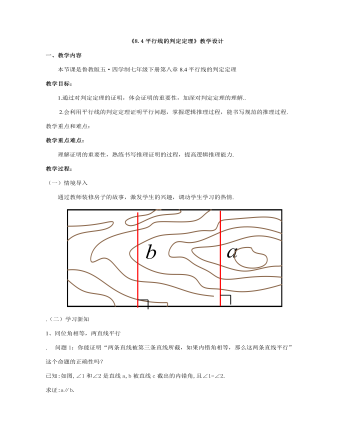
平行线的判定定理教案教学设计
问题1:你能证明“两条直线被第三条直线所截,如果内错角相等,那么这两条直线平行”这个命题的正确性吗?已知:如图,∠1和∠2是直线a,b被直线c截出的内错角,且∠1=∠2.求证:a∥b. 问题2:你能证明“两条直线被第三条直线所截,如果同旁内角互补,那么这两条直线平行”这个命题的正确性吗?已知:如图,∠1和∠2是直线a、b被直线c截出的同旁内角,且∠1与∠2互补.求证:a∥b

综合活动教案有趣的动物房子
活动目标:1.让幼儿根据小动物们的要求,设计出有趣的房子。2.培养幼儿的想像力、创造力。活动准备:1.和幼儿人数相等的16开白纸、马克笔。2.小兔、小松鼠、蝴蝶、大象等图片。活动过程:一.导入活动,激起幼儿兴趣,引出课题“房子”1.老师:小朋友,今天咱们班来了几位小客人,你们看,是谁? 幼儿:小兔、小松鼠、蝴蝶、大象。
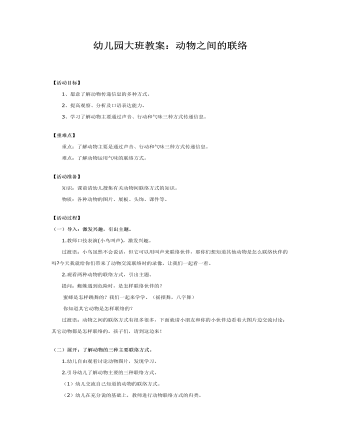
幼儿园大班教案:动物之间的联络
【重难点】 重点:了解动物主要是通过声音、行动和气味三种方式传递信息。 难点:了解动物运用气味的联络方式。【活动准备】 知识:课前请幼儿搜集有关动物间联络方式的知识。 物质:各种动物的图片、展板、头饰、课件等。【活动过程】(一)导入:激发兴趣,引出主题。 1.教师口技表演(小鸟叫声),激发兴趣。 过渡语:小鸟虽然不会说话,但它可以用叫声来联络伙伴,那你们想知道其他动物是怎么联络伙伴的吗?今天我就给你们带来了动物交流联络时的录像,让我们一起看一看。 2.观看两种动物的联络方式,引出主题。 提问:蜘蛛遇到危险时,是怎样联络伙伴的? 蜜蜂是怎样跳舞的?我们一起来学学。(摇摆舞,八字舞) 你知道其它动物是怎样联络的? 过渡语:动物之间的联络方式有很多很多,下面就请小朋友和你的小伙伴边看着大图片边交流讨论:其它动物都是怎样联络的。孩子们,请到这边来!(二)展开:了解动物的三种主要联络方式。 1.幼儿自由观看讨论动物图片,发现学习。 2.引导幼儿了解动物主要的三种联络方式。 (1)幼儿交流自己知道的动物的联络方式。 (2)幼儿在充分说的基础上,教师进行动物联络方式的归类。
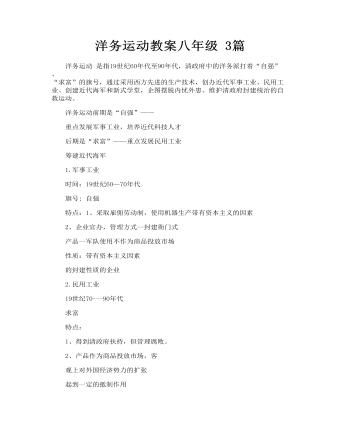
洋务运动教案八年级 3篇
1.军事工业 时间:19世纪60—70年代 旗号: 自强 特点:1、采取雇佣劳动制,使用机器生产带有资本主义的因素 2、企业官办,管理方式--封建衙门式 产品--军队使用不作为商品投放市场 性质:带有资本主义因素 的封建性质的企业

大班科学课件教案:不怕冷的植物
2、学习与同伴一起交流,感受相互交流带来的乐趣。 [活动准备]1、活动前观察过腊梅花、松树、自然角种植水仙花等植物在冬天的状况。2、班级幼儿养植过水仙花3、幼儿美术用书《立体树》 [活动过程] 一、结伴讨论1、谈话:冬天里,你见到过有哪些植物不怕泠?2、幼儿自由结伴讨论。
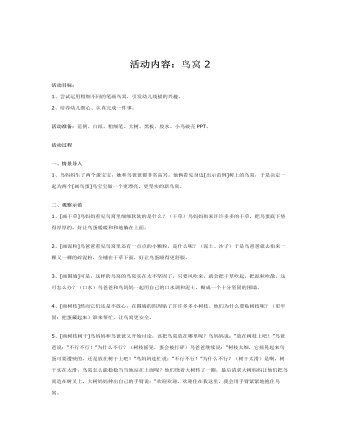
大班绘画活动:鸟窝2课件教案
2、培养幼儿细心、认真完成一件事。活动准备:范例、白纸、粗细笔、大树、黑板、胶水、小鸟破壳PPT。活动过程一、情景导入1、鸟妈妈生了两个蛋宝宝,她和鸟爸爸都非常高兴。他俩看见身边[出示范例]树上的鸟窝,于是决定一起为两个[画鸟蛋]鸟宝宝做一个更漂亮、更坚实的新鸟窝。二、观察示范1、[画干草]鸟妈妈看见鸟窝里细细软软的是什么?(干草)鸟妈妈衔来许许多多的干草,把鸟蛋底下垫得厚厚的,好让鸟蛋暖暖和和地躺在上面。2、[画泥粒]鸟爸爸看见鸟窝里还有一点点的小颗粒,是什么呢?(泥土、沙子)于是鸟爸爸就去衔来一棵又一棵的碎泥粒,全铺在干草下面,好让鸟蛋睡得更舒服。
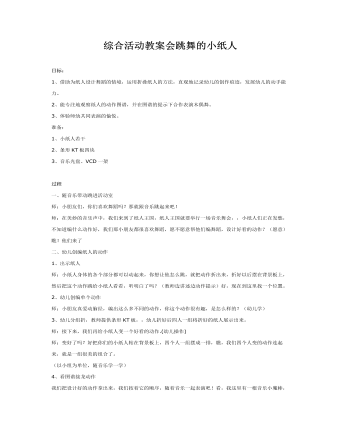
综合活动教案会跳舞的小纸人
2、能专注地观察纸人的动作图谱,并在图谱的提示下合作表演木偶舞。3、体验师幼共同表演的愉悦。准备:1、小纸人若干2、条形KT板四块3、音乐光盘、VCD一架 过程一、随音乐带动跳进活动室师:小朋友们,你们喜欢舞蹈吗?那就跟音乐跳起来吧!师:在美妙的音乐声中,我们来到了纸人王国,纸人王国就要举行一场音乐舞会,,小纸人们正在发愁,不知道编什么动作好,我们那小朋友都很喜欢舞蹈,愿不愿意帮他们编舞蹈,设计好看的动作?(愿意)瞧!他们来了

小动物怎样睡觉课件教案
2培养幼儿观察探索的兴趣,让幼儿运用各种感官,初步了解自己喜欢的几种小动物的睡觉方式,初步了解他们的生活习性。 3知道动物是人类的好朋友,体验帮助别人的快乐活动重点:了解几种小动物的睡眠方式 活动难点:能用完整的语句叙述几种小动物的睡眠方式 活动准备:1提前请家长协助搜集有关动物睡眠的资料 2故事图片磁带各种动物头饰。 3在活动区开设“小动物幼儿园”请幼儿把收集到的资料放在活动区,资源大家共享活动方法:讲解法、探索发现法、游戏法 活动过程: 1听声音做动作 教师播放歌曲《走路》,请幼儿模仿小动物的动作,同时模仿小动物的声音。 教师:刚才小朋友和哪几种小动物一起做游戏?你知道这些小动物是怎样睡觉的吗?(引导幼儿集体讨论)小猴弟弟不知道怎样睡觉,它到处去向别人学习,结果闹出了许多的笑话,让我们一起来看看猴小弟都闹出了那些笑话吧(教师播放故事《猴小弟学睡觉》) 2了解小动物的睡眠方式 ⑴教师提问: ①故事里都有谁? ②他们是怎样睡觉的? ③你能模仿一下小动物是怎样睡觉的吗? ⑵加深活动: 你还知道那些小动物的睡眠方式? 你能模仿他们睡觉的方式吗? 你是怎么知道这么多的知识的?
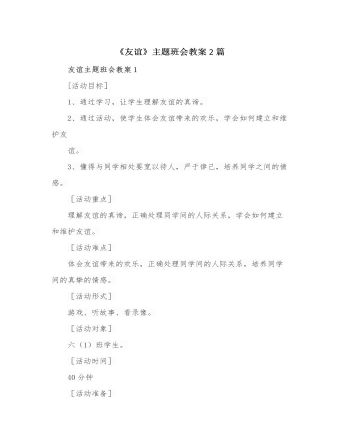
《友谊》主题班会教案2篇
三、动笔写一写为你的朋友写下一句发自内心的祝福或者写上一句真诚的“对不起”,找个机会交给他(她)??1、学生练写2、指名回答。3、学生交换卡片。四、游戏:你比我猜默契大考验学生游戏,评比出最默契的一组五、听故事《朋友,我就知道你会来》1、听故事。2、学生齐读《真正的朋友》六、全班合唱歌曲《朋友》,结束课题。友谊主题班会教案2教学目标:1.通过本次班会活动,增进学生之间的相互了解,增进友谊,营造良好的班集体氛围和学习氛围。2.让学生学会换位思考,学会为别人着想,发现并学习别人身上的优点,学会关心别人,学会信任别人,学会团结同学,提高班集体的凝聚力。教学重、难点:增进学生之间的相互了解,增进友谊,营造良好的班集体氛围和学习氛围。学会团结同学,提高班集体的凝聚力。教学过程:

